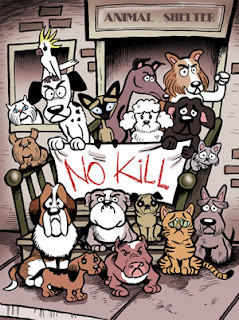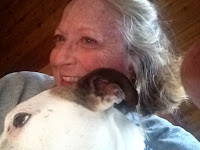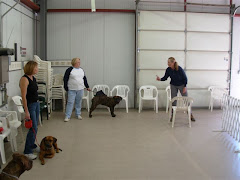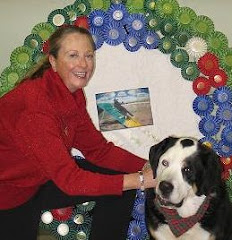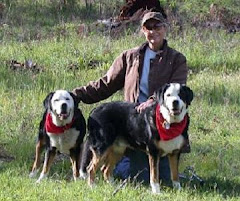Of all the "word commands" I've taught in my behavior improvement classes over the years, the hands-down favorite of my students has been
"Curb." Back when I was charging semi-big bucks for my classes, I had a woman tell me that the "Curb" command was worth the whole price of the class because "it kept Puddles from climbing into the dishwasher to do the pre-wash cycle."
Well. "Curb" does indeed keep your dog out of your dishwasher. More importantly, however, it will keep your dog from bolting out a door, gate or car. It will potentially save his life. It's also one of the easiest commands you could ever teach your dog.
Picture this: you're about to go out the front door, and you don't want your dog to bolt out ahead of you. So you look at him and say, "Listen, Buddy, you can't see it but there's an electronic barrier built into this doorway, and if you cross this barrier without my permission, you're going to get zapped big-time. Believe me, it's not worth it."
The short version of the above: simply say,
"Curb!"
You should be able to teach your dog this concept in less than one minute. Here's how you do it:
1. With your dog next to you on a leash, approach a closed door.

2. Put the leash in your left hand. Tell the dog to
"curb." Use a stern voice. Repeat the command several times for emphasis. As you do this, swing your right hand and arm from one side of the door frame to the other, back and forth, like the pendulum on a clock. You are "showing and telling" your dog something he may not yet understand, but he soon will.
3. Make sure your dog's leash is very loose...so loose that he'd be able to sneak out ahead of you if you opened the door right now.
4. Repeat the "curb" command (and signal) once more, studying your dog's reaction to it. (He will probably be ignoring you because he is fixated on the door that is about to open. This is okay!)
5. Holding the long, loose leash in your left hand, open the door with your right hand and proceed to walk through it. As you do this, look down at the threshold and your dog's feet. You are expecting him to move forward through the door. Let him start.
Do NOT hold him back!
6. If/when the dog's front feet cross the threshold (which is the "barrier" you were trying to show him), say
"NO!" or "
AAGGH!"as you jerk him back or bump him back with your legs. Quickly close the door (if there is one) and start over. Immediately repeat the command and signal using an even sterner voice. Study your dog's body language. He should look startled, somewhat bewildered, maybe even mildly alarmed.
7. Now show and tell him to curb again, open the door, monitor the threshold and proceed to walk through the door. If your dog once again breaches the line with his front feet, correct him back again (with even more shock and awe), and once more repeat the command to curb. Your aim is not to hurt your dog, but rather to startle him into thinking about the gravity of that new word he's just learned.
8. The third time you open the door, you should see your dog choose to stand clear of the threshold, looking submissively at you and waiting for further directions. He may even back up or glance sideways when you say the word. At this point you know your dog is thinking (instead of simply reacting) and making a conscious choice to do the safest thing, which is to remain behind the curb line you have established.
9. At this point, immediately move back into the room to your dog and praise him lavishly! Tell him "Good curb!" and let him know he did the right thing.
10. Now, try it again. You're simply reinforcing now, and chances are you'll have success without any correction. Your dog will stand there looking at you and waiting for your next cue. When you come back to him, you'll see his ears dip back and he'll probably do a sweet, submissive little wiggle that says, "I did it right, didn't I?" Praise him!
You've just taught your dog the main concept of "Curb," which is, "Remain behind this line until I tell you to do something else." You have used the element of surprise to make your very first correction meaningful. You showed your dog that there are immediate, clear, predictable consequences for actions. Your dog will never forget this lesson because it's as indelibly etched in his brain as if he'd bumped into an electric fence.
You could use the above scenario for curbing your dog inside while you momentarily step outside to retrieve a UPS package left on your front porch...or while setting a bag of garbage outside the back door. In each situation, you return across the curb line to your dog.
Now, let's say you and your dog are both going out the door. He's pushy and wants to get out the door ahead of you. Here's how you handle that situation:
1. Curb your dog as described in the section above.
2. Leave the dog and step across the curb line.
3. Once you have gotten out ahead of your dog and are ready to release him to go with you, simply give him an "Okay!" and invite him to come across the line to you. At this point, have the leash in your hand so you can give him a friendly little tug toward you if he is hesitant to cross the line. Reward as he come to you and continue on your way.
This technique can also be used when you're getting your dog out of the car. If he rides in the back seat, you must first get out of the car. Next, stand outside his closed door and tell him to "Curb." Slowly and carefully open the door, grab your dog's leash, and then release him out of the car with an "Okay!"
Some rules about the use of "curb"
- Always say "Curb" BEFORE you open the door or gate, or before you cross the line yourself. This puts your dog on alert and can prevent an unsafe escape.
- Always be ready to correct sharply if your dog's toes cross the line before you release him.
- Your dog need not be at the door when you curb him. If he's playing in the room, you can go to the door, tell him to "curb," and then just leave. He can continue playing, as long as he does not cross the curb line.
- Only use "curb" when you are there to enforce it. Don't expect it to replace a fence or actual gate. Use it when you can keep an eye on your dog to make sure he does it right.
- When possible, try to use a visual "line of demarcation" on the floor. A change in surface (i.e., from carpet to tile) is a good curb line, primarily because it helps you know precisely when to correct the dog. If you correct the dog too soon or too late, he will become confused and frustrated, and learning will stop.
- Start by practicing "curb" on small doorways and passages that are easily defined by both you and the dog. Next, graduate to less specific and larger openings, like garage doors or corral fencing. As long as you indicate with a verbal command and a pendulum arm signal, your dog will have the idea that he must not cross the invisible line drawn by your hand.
- Be as firm and consistent with your corrections whether it's a critical curb or a convenience curb. The dog must know there are always negative consequences when he breaks a curb line.
Is this cruel or harsh training?
It's real-life learning. Some of the most important safety lessons we ever learn are etched in our mind because of immediate negative consequences. Put your hand on a hot stove and get burned. Grab and electric fence and get shocked. Exceed the speed limit and get a big ticket. These lessons potentially save our lives too.
Why "curb" instead of "stay"?
Whenever possible, give the command that is easiest for you to enforce and easiest for the dog to do. When you say "Stay," you should be asking him to freeze in his current position and not move until you release him. That's usually more restrictive than necessary. You are also obligating yourself to strictly enforcing that "stay" command once you give it. "Curb," on the other hand, simply tells him he can do whatever he wants, as long as he doesn't cross the line. Which is less restrictive to the dog? Which is easier for you to enforce? It's "curb," of course.
Why not say "Wait"?
Personal preference. I prefer "curb" because it sounds a bit stronger, a bit more intimidating. But I've had many students who chose "Wait" because they'd already introduced their dogs to a similar concept with this word. Whatever you choose, be consistent.
Ways to use "curb" around the house:
- At the tops and bottoms of stairs to keep your dog from tripping you.
- Inside when you are going in and out the sliding patio door checking your barbecue grill.
- Keeping your dog out of your immediate cooking area in the kitchen.
- Keeping your dog from jumping into your car before you've cleared a place for him to sit.
- Keeping your dog in the mud room until you can grab a towel to wipe his muddy feet.
- Keeping your dog from crowding the front door when someone rings the doorbell.
- Keeping your dog out of the kitchen while you're washing the floor.
- Keeping your dog backed up away from the dishwasher when you're loading it!
Ways to use "curb" away from home:
- When you and the dog are approaching the door of a commercial establishment. Seeing your dog "curb" will let everyone know your dog is trained and well behaved.
- Getting your dog in and out of the gates at a dog park.
- Getting off an elevator with your dog.
- Preventing your dog from jumping out of your RV into an unsafe situation.
- Preventing your dog from jumping from the back seat into the front seat when you are driving.
 Use it 50 times a day whether you need to or not
Use it 50 times a day whether you need to or not
Don't wait for the "really important times" to use this command. Use it regularly, every time your dog is following you through doorways in your home. Use it every time you're getting your dog in or out of the car, his crate, or his backyard kennel.
Your dog likes it too
The "curb" command, used frequently and responsibly, will make your dog feel secure in your presence, because he knows you're watching him. Our dogs are constantly looking for meaningful employment with us, so consider this a "job" you can give them many times a day. They'll be willing workers, finding gratitude in the mere opportunity to please you.
More important than "Come!"
Even a dog who is trained to come when called may fail the exercise when he escapes out the front door and runs wildly down the street. If he is taught to respect the curb command at the door, the incident will never happen in the first place. Prevention--with the curb command--is the best medicine of all!
 That said, “sit” is a handy command for your dog to know,
particularly when you start adding the “stay,” which is like glue or Velcro to
the dog’s body position.
That said, “sit” is a handy command for your dog to know,
particularly when you start adding the “stay,” which is like glue or Velcro to
the dog’s body position.







